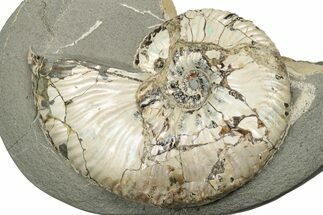This Specimen has been sold.
3.5" Cut & Polished, Pyritized Ammonite Fossil - Russia
This is a pyritized ammonite (Quenstedticeras sp.) fossil that was collected from a Middle Jurassic deposit along the banks of the Volga River near Saratov, Russia. It has been cut in half and polished across the flat faces, revealing the pyrite encrusted chambers. You can feel the heft of the iron pyrite in the specimen when you hold it in your hand. Some of the chambers feature gorgeous natural iridescence.
Comes with an acrylic display stand for each half. Larger ammonites from this location will commonly be disarticulated or poorly preserved at their centers. For this reason, there is some gap fill at the center and within some of the chambers.
Comes with an acrylic display stand for each half. Larger ammonites from this location will commonly be disarticulated or poorly preserved at their centers. For this reason, there is some gap fill at the center and within some of the chambers.
About Ammonites
Ammonites were ancient marine cephalopods, similar to today's squids and octopuses, but with a defining feature: their distinctive, tightly coiled spiral shells. These shells, resembling those of modern nautiluses, served as both a protective home and a buoyancy aid, allowing ammonites to navigate the prehistoric seas with ease. First emerging around 240 million years ago in the Triassic Period, ammonites thrived for over 175 million years, adapting through numerous forms and sizes. As predatory creatures, they likely fed on smaller marine organisms, using their tentacles to capture prey. However, their long reign came to an end 65 million years ago at the close of the Cretaceous, coinciding with the mass extinction event that also eliminated the dinosaurs.
Ammonites were ancient marine cephalopods, similar to today's squids and octopuses, but with a defining feature: their distinctive, tightly coiled spiral shells. These shells, resembling those of modern nautiluses, served as both a protective home and a buoyancy aid, allowing ammonites to navigate the prehistoric seas with ease. First emerging around 240 million years ago in the Triassic Period, ammonites thrived for over 175 million years, adapting through numerous forms and sizes. As predatory creatures, they likely fed on smaller marine organisms, using their tentacles to capture prey. However, their long reign came to an end 65 million years ago at the close of the Cretaceous, coinciding with the mass extinction event that also eliminated the dinosaurs.
SPECIES
Quenstedticeras sp.
LOCATION
Volga River, Saratov, Russia
SIZE
Largest Half: 3.5" wide
CATEGORY
SUB CATEGORY
ITEM
#198341
We guarantee the authenticity of all of our specimens.
 Reviews
Reviews















